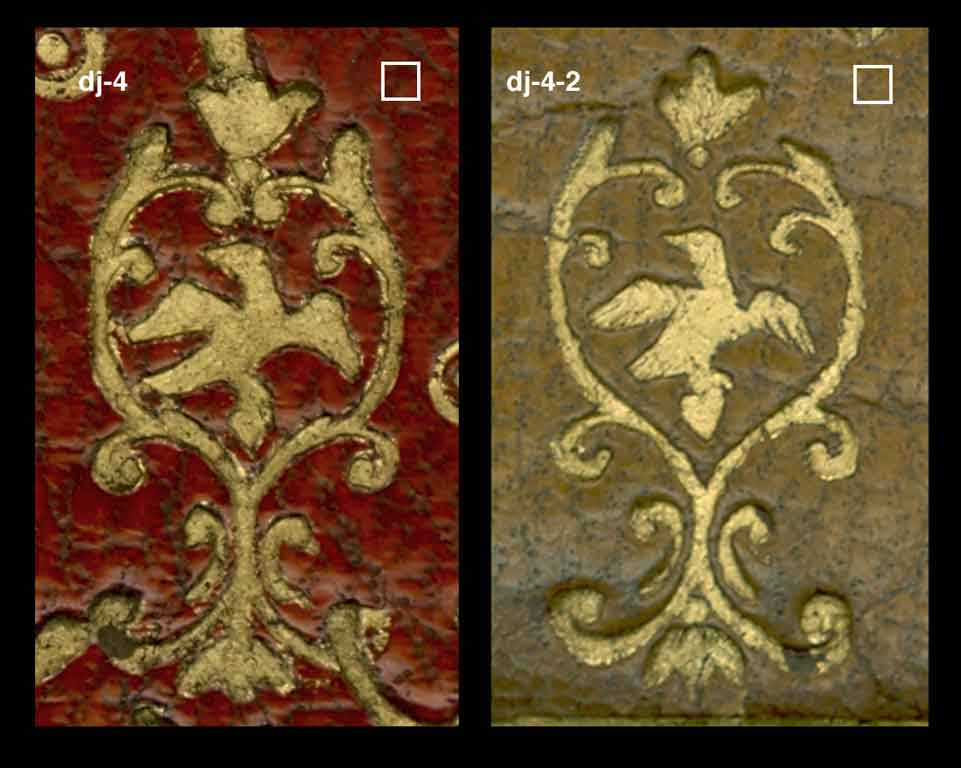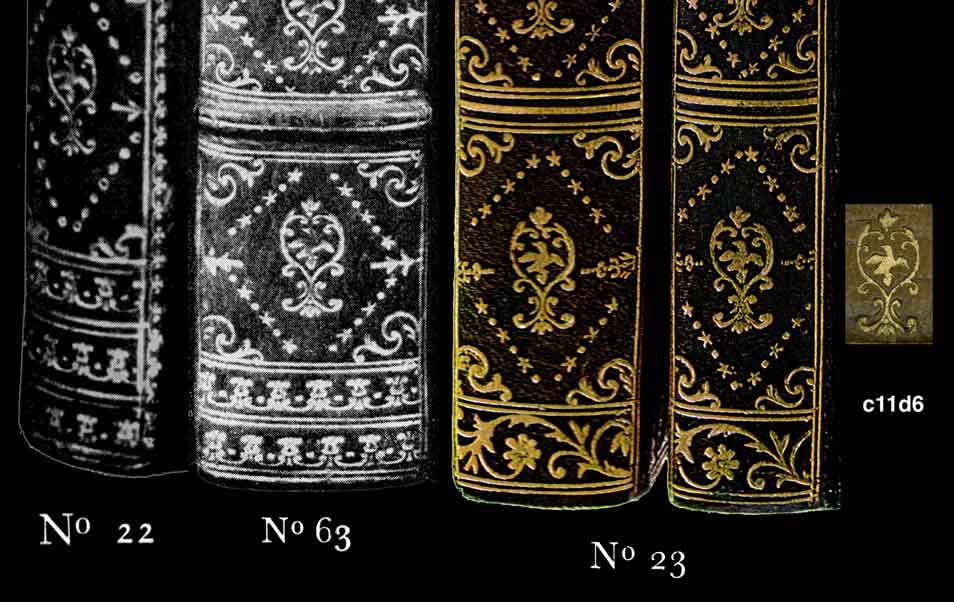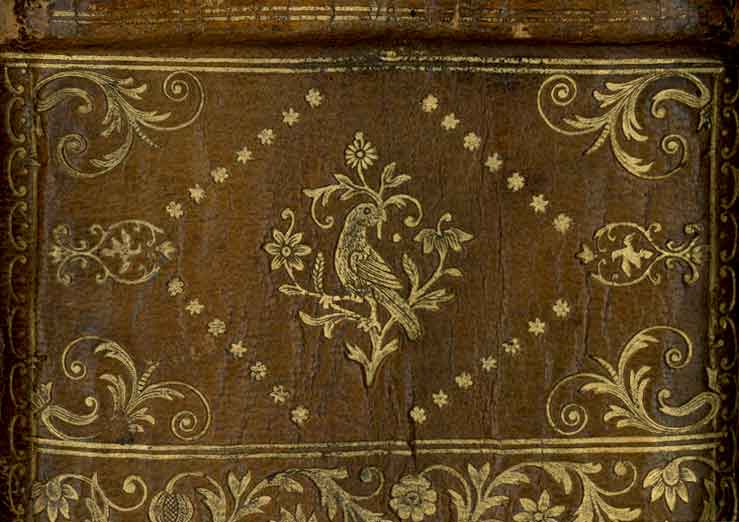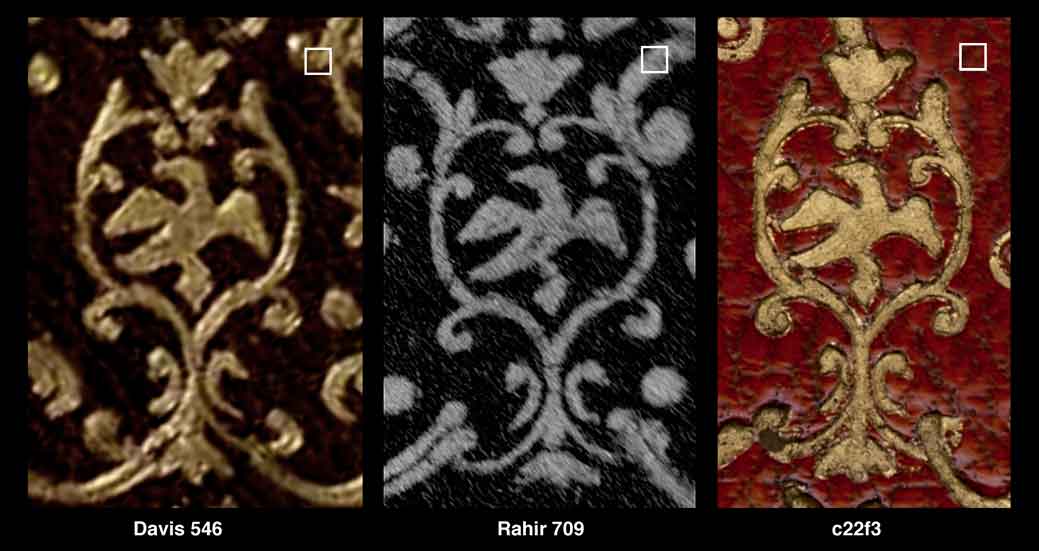

|
Thanks to Phillipa Marks, curator of Bookbindings at the British Library, we now have an excellent image of a second fer à l'oiseau tool of Derome le jeune (dj-4-2). Did you know that he had two tools of this kind? I have never seen any sort of detailed study concerning the fer à l'oiseau of Derome le jeune even though it is mentioned endlessly in bibliophilic works that concern the dentelle bindings of the 18th century. Possibly the most important diagnostic tool in the history of decorative bookbinding and yet we find no published works that show us, in detail, what this famous imprint actually looks like, let alone the possibility of a second Derome tool of this type. On the previous page we were looking at a binding reproduced by Esmerian in his 1972 catalogue, Volume III, item number 23 (click here to see this page). This binding is decorated with a large dentelle that was executed by Jean-Pierre Jubert, inside this binding we find the ticket of Derome le jeune, and consequently the binding has been attributed to Derome. At the bottom of the page I compared the spine of another Derome binding with the spine of item 23. On both spines we see, in the center of the compartments, a fer à l'oiseau imprint. To my eye these birds looked the same but they were not the same as my catalogued Derome le jeune imprint (dj-4). The catalogued imprint is a 'type' specimen based on all the Derome le jeune examples collected from dentelles. I assumed there was only one type as I had only found one, however, as we rarely see spines in binding reproductions my knowledge of this imprint was based on examples extracted only from dentelles. When I first saw this different type of fer à l'oiseau on the spines of item number 23, thought that they might be from the tool kit of Jubert, however similar imprints on another, more obvious Derome binding (also found in Esmerian's catalogue Volume I, item 22), brought me to an impasse. |

| In Comparative Diagram 2, I show the spine compartments of the bindings mentioned above as well as the spine another Derome binding, number 63 from Esmerian's 1972 catalogue Volume III, these then are compared from an imprint extracted from the spine of another signed Derome binding that is found in the British Library, shelf marked c11d6. Below I show this spine compartment with the fer à l'oiseau imprints that are in an unusual horizontal position. Sent to me by Philippa Marks, this 600 dpi scan, shows an unusually clear example of this imprint, that is proof of a second Derome tool of this type. |

| At the top of the page I have reproduced an enlargement of the c11d6 fer à l'oiseau next to the standard Derome fer à l'oiseau (dj-4). We can see that even though many details of this imprint are nearly identical, the two imprints are different. This is a big breakthrough in the identification of Derome's work. It may be that Derome used this second tool (dj-4-2) exclusively on the spines. Also it changes somewhat my view of Jubert's arrangement with Derome. Jubert incorporated some of Derome's tools in his dentelles, but he did not use the dj-4 fer à l'oiseau in these dentelles using instead his own tools of this type. In item number 23 we see that Jubert has used his own tools to make the dentelle while on the spine we see only Derome tools. On the next page we are going to look at a Derome signed binding that is found in the British Library Database of Bookbindings. This is shelfmark c22f3 one of the most obvious and famous Derome binding examples. I have taken a fer à l'oiseau imprint from the dentelle of this binding to use here as an example in Comparative Diagram 1, however the top of the crown appears ragged as though a piece may have broken off. Below I show three dj-4, examples the first is from Davis 546, here the crown appears pointed and more like the crown of dj-4-2. The black and white example in the middle is from the Rahir 709 binding and dates to at least 1773, here we see a flattened, p[ossibly broken crown, the third example is from c22f3. According to Pascal Ract Madoux's Essai de classement chronologique des étiquettes de Derome le Jeune in Bulletin du Bibliophile no 2 Paris, 1989. The Derome étiquette found in c22f3 indicates a post 1780 date for the execution of this binding. If in fact the top has broken off, it happened before 1773. We can now move on to the next page, where we will explore more high resolution images of an authentic Derome le jeune binding. |

|
click on this link to go to the next page: Derome up close (work in progress)
click on this link to return to: the Jubert Links page |
| information about the author | visit cyclopaedia.org |